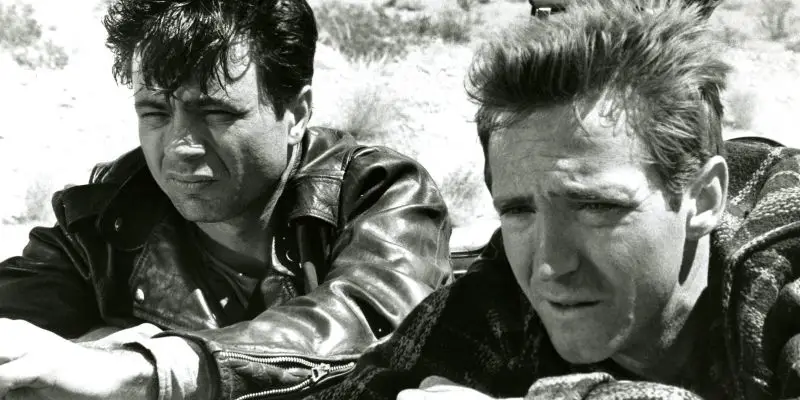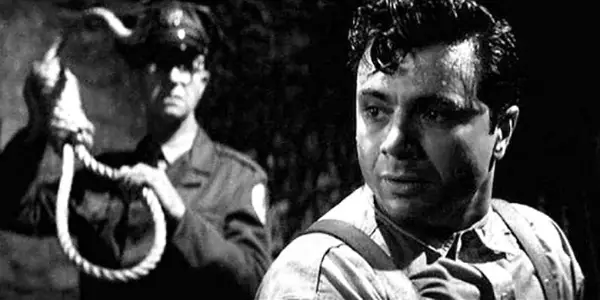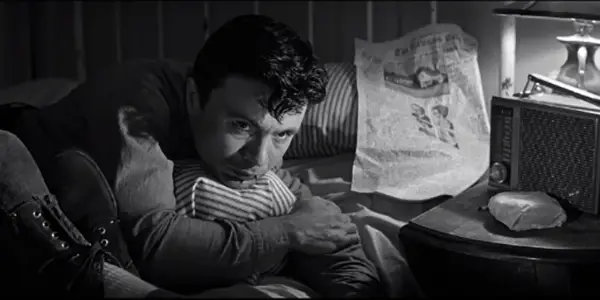IN COLD BLOOD: A Film Noir of Natural Born Killers

Amanda Garrett is a freelance writer with a passion for…
On a chilly night in November 1959, two desperate young drifters slaughtered a family outside Holcomb, Kansas for $40, a pair of binoculars, and a transistor radio. The macabre slayings and the manhunt, trial, and execution of the pair of “natural born killers” who committed the crimes gripped the nation. Celebrated writer Truman Capote published a bestselling book about the case called In Cold Blood that was turned into a gripping 1967 movie, which is one of the best of the later film noirs.
Now, In Cold Blood is back in the spotlight thanks to a 4K digital restoration from the Criterion Collection that is available on DVD and Blu-ray in the United States. Writer and director Richard Brooks transforms Capote‘s true crime tale into a stylish black-and-white film about those on the outskirts of American society and the injustices of the criminal justice system.
A True Crime Tale
For those who don’t know, In Cold Blood tells the story of Dick Hickock (Scott Wilson) and Perry Smith (Robert Blake in the performance of his career), two small-time hoods who drift around the Midwest bouncing checks and shoplifting in-between stints in jail. The two men, who are both low on money and without jobs, decide to earn some quick cash by robbing and killing Herbert Clutter (John McLiam) and his family; Clutter is a wealthy wheat farmer who Hickock believes has $10,000 stashed in a safe at his remote farmhouse. Things immediately go awry when Hickock and Smith arrive at the Clutter farmhouse around midnight on November 14, 1959, when they discover that Clutter has no safe and he only has around $1,000 in the bank. Hickock and Smith refuse to believe that their pipe dreams of a huge payday won’t come true, which leads to a series of chaotic events that spiral into a murderous rage.
Brooks, who was a successful screenwriter and director of socially relevant films like Elmer Gantry (1960) and Sweet Bird of Youth (1962), was immediately captivated with the material after reading Capote‘s book. He set out to make a film that would be a realistic recreation of the actual events.”I see this as a Greek tragedy, American style,” Brooks told the New York Times. “Everybody knows the ending. It’s the treatment that matters.”

From the beginning, Brooks stayed true to his vision. Columbia Pictures executives wanted big movie stars like Paul Newman and Steve McQueen to play Hickock and Smith; instead Brooks chose Wilson, an untested actor who had only appeared in one previous film, and Blake, who was then best known as a child star of the Our Gang series of short films. Brooks also insisted on filming on the actual locations where the events occurred. The real Clutter farmhouse and the real Kansas courtroom where the trial was held are used in the film, and Brooks persuaded some of Holcomb’s citizens to appear in small roles.
Although Brooks insisted on verisimilitude in some areas, In Cold Blood is not filmed in a documentary realism style. Instead, it is one of the last great film noirs with its stylish black and white cinematography by Conrad Hall and a moody, dissonant jazz score by Quincy Jones. In fact, Brooks makes the movie’s noir roots quite obvious. There are several shots that are partially lifted from earlier films, especially a movie projector scene that is a direct homage to Citizen Kane (1941). Brooks and Hall also give a tip of the hat to several noir tropes: rainy night scenes, shadowy figures lit only by cigarette matches, etc.
The noir association is made stronger by Smith, who idolized Humphrey Bogart. Smith continuously name checks Bogie and his 1948 film, The Treasure of the Sierra Madre, throughout In Cold Blood, and he even draws a portrait of the actor while on death row. There are also several references to double indemnity insurance policies, which is a direct homage to Billy Wilder‘s 1944 masterpiece.
An Analysis of “Natural Born Killers”
Brooks also changed the focus of the story. While Capote‘s book gave equal time to the Clutter’s and the detective who cracked the case (played by John Forsythe in the movie), Brooks places the emphasis squarely on Hickock and Smith. Blake’s sympathetic portrayal of Smith is actually the central focus of the film version of In Cold Blood. The audience experiences all of the movie’s events, from the murders to the trial and execution, from Smith’s perspective. Brooks also gives the audience a glimpse into Smith’s troubled psyche: he is portrayed as a sensitive and artistic person, and several flashback scenes of Smith’s troubled childhood are added to garner sympathy for the wayward young man.

This is a canny decision for two reasons. First, Smith is the more sympathetic of the two killers. Hickc*ck, a cowardly psychopath whose only discernible skill was passing bad checks, is the mastermind of the plot who drags a reluctant Smith along because he is too frightened to commit the grisly murders on his own. Blake is also a better actor than Wilson, and his subtle underplaying of the character works much better than Wilson’s more showy style (ironically, Blake would have his own run-in with the law in the 2000’s when he was tried and acquitted for the murder of his second wife).
While the emphasis on Smith and Hickock makes dramatic sense, it is also deeply troubling. Capote himself complained about this aspect of the movie. “The book was about six lives, not two,” he said in an interview quoted on the TCM database. Smith certainly deserves the audience’s sympathy – the psychological wounds from his troubled childhood were probably compounded by intellectual disabilities – but he was not an innocent. He had killed a man before the Clutter murders, and he and Hickock’s life of shoplifting and check chiseling deprived many an honest person of their livelihoods.
In Cold Blood ends very much like it began, in the grip of violence, this time with the state-sponsored hangings of Hickock and Smith. The executions are depicted in excruciating detail right down to the hangman’s fidgeting with the noose, and with Smith’s pathetic fear that he will soil himself during the execution. This strategy is undeniably effective (In Cold Blood and in particular this scene are a triumph of skillful editing), but in some ways it rings hollow. There are many problems with the death penalty in the United States – it is not a deterrent to crime, and innocent people have been executed – but are we right to cry for Smith when the Clutter’s, who were tied up and slaughtered like livestock, lie cold and guiltless in their graves?
How do you rate In Cold Blood among film noir? How do you view the depiction of capital punishment in this movie?
Does content like this matter to you?
Become a Member and support film journalism. Unlock access to all of Film Inquiry`s great articles. Join a community of like-minded readers who are passionate about cinema - get access to our private members Network, give back to independent filmmakers, and more.
Amanda Garrett is a freelance writer with a passion for classic films. You can catch her writing reviews and features at Film Inquiry or at her website, Old Hollywood Films.













